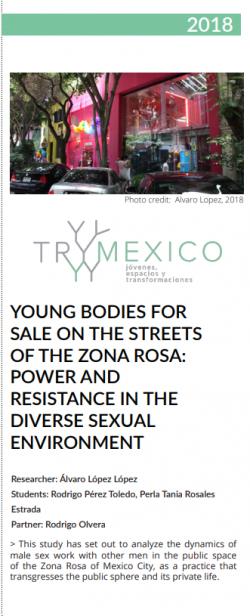Male sex workers on the street
mexico

In Zona Rosa, sex workers are invisible to those who do not know body language codes. These young prostitutes make themselves visible by moving their bodies in a certain way when they see a potential client. How is this (in)visibility regulated? How do these young people articulate the virtual public space (meeting places) and physical space?
La Zona Rosa is a central neighborhood known for its many places of homosocialization. Located very close to the historic center, on the elite corridor known as Reforma, it is a place visited by many tourists and locals. It is the core of Mexico’s “gay identity.” It is also a place for masculine street sex work. But most male sex workers do not identify as gay. Instead, they tend to simply represent themselves as hombres (men).
How do masculine sex workers regulate their work? How do they play with (in)visibility? How do they define and perform masculinity? How have their work changed with the increasingly important use of online platforms? What is the relationship between the street, the web, the bars, and the hotels? For most male sex workers, at 30 years old you are old. How to understand youthfulness in this context?
[layerslider id=”10″]
Transcript
“Geography is the reflection of the phenomena in which the human being is involved and how those phenomena of the human being have an interaction with the environment, what we call geographical space. So we would have to assume that the human being in his evolution, presents similarities and diversities depending on the circumstances of the social space in which he lives.
Hence, I believe that this reflection of male sex work for this TrySpaces project within geography is very interesting, because it will allow us to reflect on the commercial sexual interaction of individuals based on circumstances surrounding this phenomenon of sexuality, which it has to do with the regulations of Mexico City, which have to do with the social tradition and customs of the population and to what extent this social and cultural issue determines certain behaviors or not, facilitates or limits them. So a study of sexuality and male sex trade involves knowing the different interactions that limit or promote this dynamic in spatial terms.
A very interesting question for this project would be if really these young man who are making use of this public space, somehow transgress it or not to the extent that the exercise of their work is as discreet as possible, trying not to break into that environment, because sex work, after all, takes place at night, very late. There is a contracting code between the contracting
parties and between the bidders, which in some way this series of codes are basically handled by the characters involved in this. This would be a very interesting question in the investigation, how far does the transgression go?
Another issue that I find interesting in this project is the question of what public space is. Does the public space only remain in
the reflection of the street or does it also involve other types of areas, such as virtual spaces or the internet? And the question is, has trade and sex work declined?
I believe that to make known this type of phenomena allows us to see the diversity that we as a society have and the freedoms that all individuals seek. So just as there are spaces for fun, there are also the spaces of sexuality. Then, I believe that we as a society must prepare ourselves to be open to different forms of sexual interaction, as long as there is a consensus among the parties involved.”


Click here for 2020 A4 format printable version and 8.5 x 11 format printable version.
Click here for 2019 A4 format printable version and 8.5 x 11 format printable version.
Click to consult the web version of case study summary sheet for the year 2018 and click here for the 2018 printable version.












